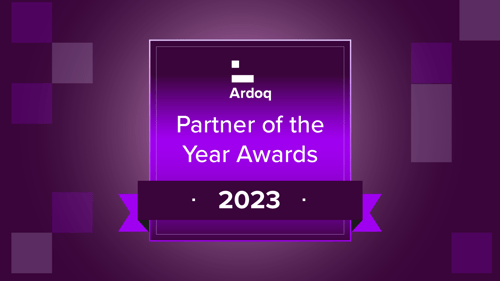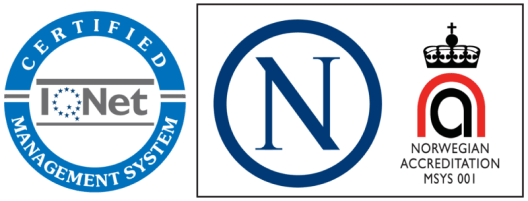We’re extremely proud to announce that Gartner®, which delivers actionable, objective insights to executives and their teams, has positioned Ardoq in the Leaders’ Quadrant in the “2021 Magic Quadrant for Enterprise Architecture Tools”.
We believe this recognition confirms our vision for next-gen, data-driven Enterprise Architecture tools and validates our position as a leader in the space.
Learn how a comprehensive product vision, positive sales experience, and intuitive user experience contributed to high levels of customer satisfaction and helped position Ardoq as a Magic Quadrant Leader among Enterprise Architecture (EA) platforms.
What Does It Mean to Be Positioned as a Leader in the 2021 Gartner® Magic Quadrant for Enterprise Architecture Tools?
The Gartner® Magic Quadrant gives enterprise technology leaders a rigorous, fact-based assessment of how well competing providers are performing against Gartner’s market view. Each report comes with a Magic Quadrant graphic that depicts a market using a two-dimensional matrix that evaluates vendors based on their Completeness of Vision and Ability to Execute. This year’s report evaluates 16 EA vendors and carefully looks at their strengths and weaknesses.
According to Gartner:
“EA tools allow organizations to examine both the need for, and the impact of, change. They capture the interrelationships and interdependencies within and between an ecosystem of partners, operating models, capabilities, people, processes, information, and applications and technologies.”
To thrive in today’s business environment and propel your change journey forward, you need data-driven tools that both support effective decision-making and that help you meet your business objectives. Choosing the right EA solution is an essential step for achieving these goals. Per our understanding of the report, our flexible metamodel, user experience, and use case journey were some of the reasons that we believe helped with our recognition.
From a Business Question to Tangible Results in Record Time
If you work in a business that has to adapt to competition, consumer behavior, or new regulations, you probably need a map to know where you’re going and why. In order to know how to use that map, you may need some help learning to read it first.
Let's look at an example. Say your company roasts and sells premium-grade coffee beans. Last year, sales hit the roof, and your company is growing. In order to meet demands, you decide to expand on your operations. However, going from a small production with a loyal group of customers to a high-tech facility doesn't happen overnight.
To fully expand your operations, you need to add new roasters, new facilities, and more coffee bean suppliers to the production line. Your new hires will need to understand larger-scale logistics and train your current staff on how to run larger roasters. Finally, you will add more suppliers and reach more potential consumers.
This is where the map comes in - showing you what you have, so you can identify what is lacking. With the map, you’ll actually create a Digital Twin of an Organization (DTO), which gives a visual overview of what you have and what you need, so you can model the outcomes of different business decisions.
Now every stakeholder can easily get the information they need to make decisions on what suppliers to use and where materials should be stored. Management can then easily see which competencies need to be acquired. The logistics manager can easily see current suppliers, materials, and storage facilities. Marketing wants to know which features to highlight. Finally, the CFO and CEO can devise a plan to pay for this scaling. This is all available in Ardoq.
Fast Time-to-Value
With tight project deadlines and high market demands, it is critical that the time needed to onboard and start using Ardoq goes smoothly and quickly. To show quick value on the return on investment (ROI), we’ve created an onboarding program tailored to organizational needs, goals, and use case journeys. It is equally important that the user(s) of Ardoq know how to navigate the flexible tool and can gather the information they need with accuracy. Without a good onboarding program, customers fail to meet their goals. Which means that we fail to meet ours.
That’s why we take onboarding seriously at Ardoq. We have made mistakes and learned from them, adjusting and easing the onboarding experience. In fact, we have a team dedicated to quality onboarding.
When starting with Ardoq, every customer gets a dedicated Ardoq expert. This customer advocate follows you through the entire onboarding process. They are always easy to reach and take note of any hiccups you might encounter along the way. That way, we can continue to adjust and learn ourselves.
We learn by doing, and we find that our most successful customers do too. One of our newest features is gamified simulation training. Through this simulation training, you can get certified in the new skills gained from using Ardoq and navigate the tool confidently.
Populating the Data
To return to our example, the coffee roasters haven’t exactly had time to keep track of their data very well. They may be scattered across departments or tools that perhaps don't communicate with each other, which then leads to frustration and roadblocks in projects. Everything in the roasting company is logged in Excel. Our Integrations can pull and collect this data, converting it for Ardoq.
Taking this step to import existing data will help you reach your objective as fast as possible, and maybe more importantly, show the value of what has already been done.
Our best practice guides establish a fine balance between conformity and flexibility. The guides are all built to define your organization's Enterprise Architecture roadmap based on your goals and our Use Cases. By using this roadmap, we make sure to cover all aspects of your problem to ensure the quality and validity of your outcomes.
Build a Flexible Roadmap for Desired Outcomes
At the heart of Ardoq is a powerful graph database with endless possibilities and applications. We pride ourselves on that flexibility. However, flexibility comes as a double-edged sword, and it can be daunting for some. Large domains like Application Portfolio Management and Infrastructure cover many different areas, so even within a domain, it can be hard to know where to start and what to do. Gathering all the necessary data can quickly start to look like a spontaneous, chaotic road trip that involves a lot of backtracking.
The Use Case Guides were built to map out a clear route for you. They exist to help you focus on specific problems in a domain or across multiple domains and to give you the tools to answer those questions.
Use Case guides come with pre-defined metamodel configuration, pre-built queries, views, and dashboards. They also give you descriptive techniques for populating it, using it, and delivering. With Ardoq’s Use Cases, we are with you step-by-step in your Enterprise Architecture journey. All use cases leverage and enrich the same graph data set, allowing for better and faster insights.
Almost 75% of our global user base begin their Enterprise Architecture journey by mapping their application portfolio. If they have a clear strategy, Application Portfolio Management shows them how they can gain overview and power over their IT investments. With this whole picture, they can focus on their capabilities and priorities in the business, maximizing impact.
Embracing and Leading Data-Driven Change
Our most successful long-term customers continue to create value beyond their initial project. Ardoq is an extremely flexible tool, and your next step will depend on your scope. Our Use Cases help with anything from IT cost and lifecycle management to cloud migration. We also make it possible for customers to customize our out-of-the-box solutions beyond our best practices.
The Use Cases guides offer a starting point that can be easily extended or adapted to take full advantage of our flexibility, allowing Ardoq to adjust and change with you and your organization.
Harness our global experience and competence to deliver predictable outcomes in your organization.
Disclaimer
- Gartner, Magic Quadrant for Enterprise Architecture Tools, By Gilbert van der Heiden, Akshay Jhawar, Nolan Hart, 9 November 2021
- Gartner does not endorse any vendor, product or service depicted in its research publications, and does not advise technology users to select only those vendors with the highest ratings or other designation. Gartner research publications consist of the opinions of Gartner's research organization and should not be construed as statements of fact. Gartner disclaims all warranties, expressed or implied, with respect to this research, including any warranties of merchantability or fitness for a particular purpose.
- Gartner and Magic Quadrant are registered trademarks of Gartner, Inc. and/or its affiliates in the U.S. and internationally and are used herein with permission. All rights reserved.
- This graphic was published by Gartner, Inc. as part of a larger research document and should be evaluated in the context of the entire document. The Gartner document is available upon request from Ardoq.
 Leah Plotz
With over ten years of experience working in content, Leah wants to make sure Ardoq empowers engagement and collaboration throughout an organization.
Leah Plotz
With over ten years of experience working in content, Leah wants to make sure Ardoq empowers engagement and collaboration throughout an organization.








